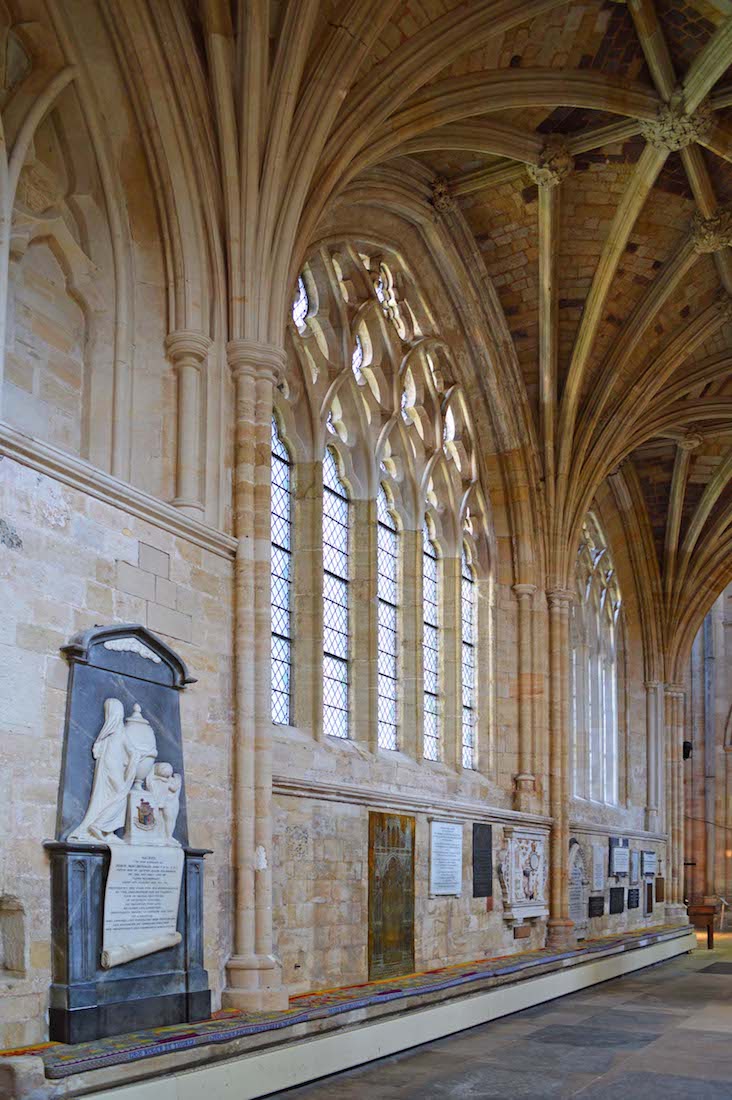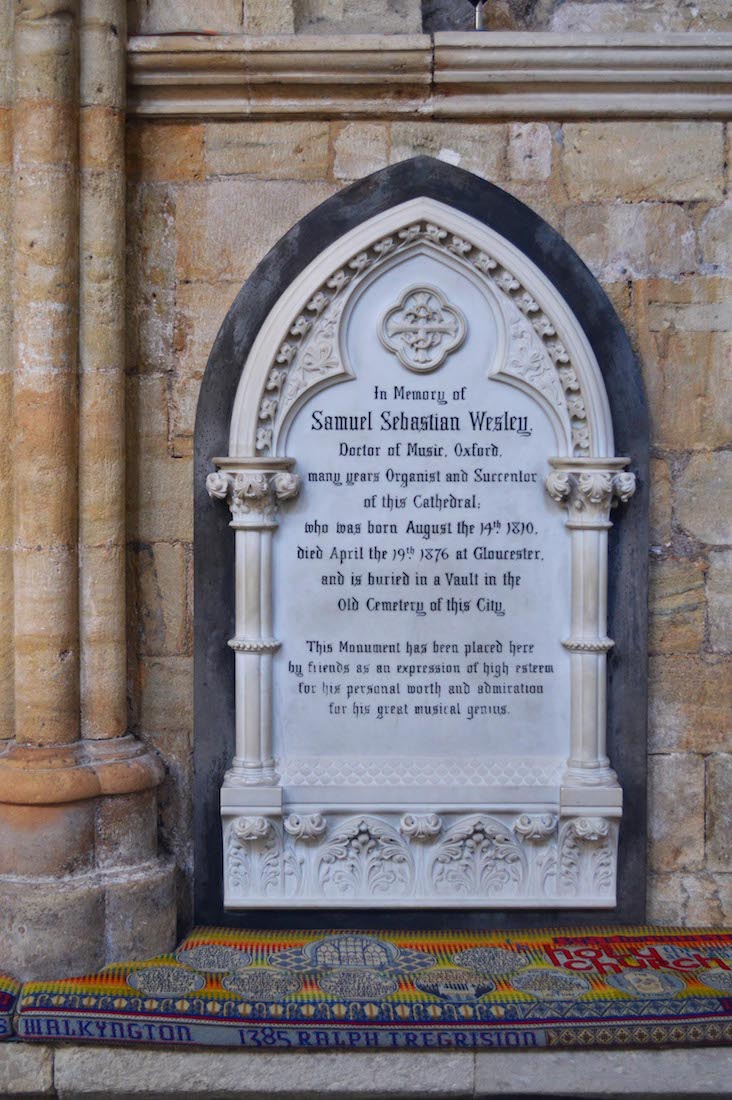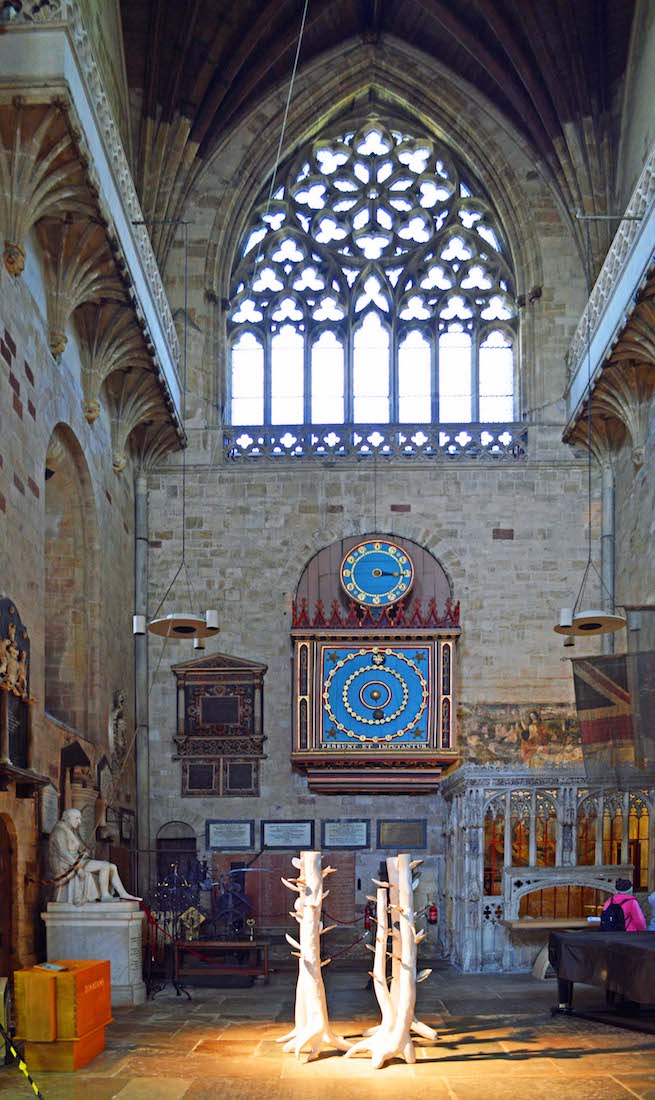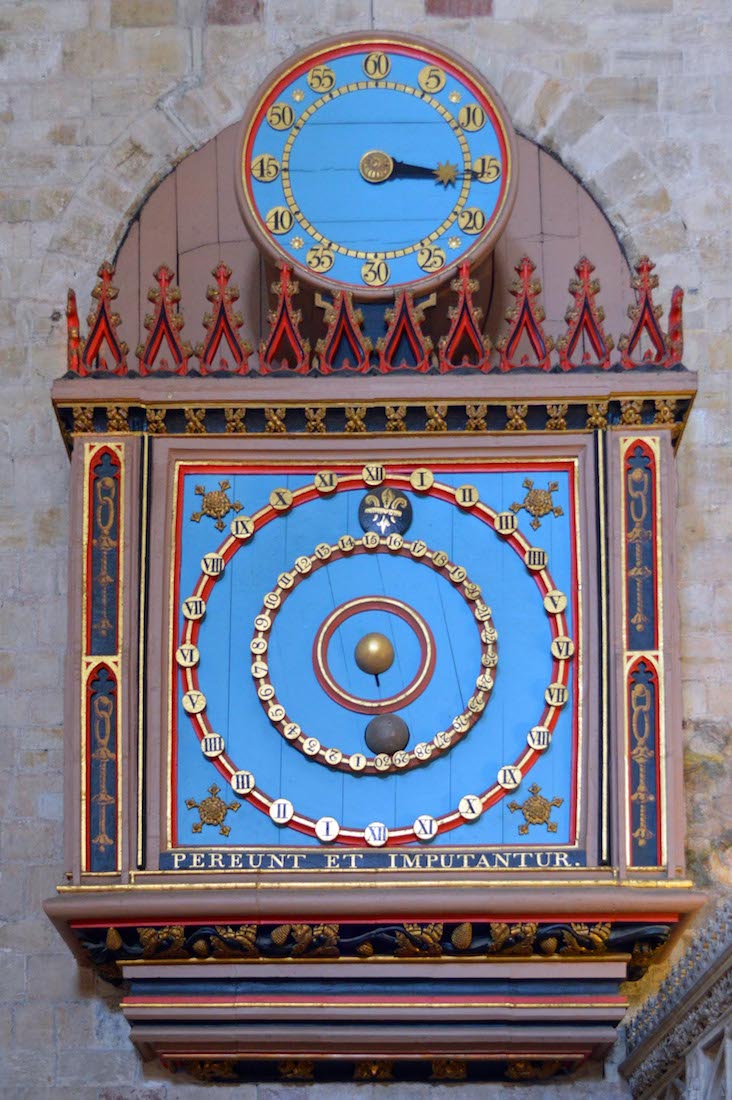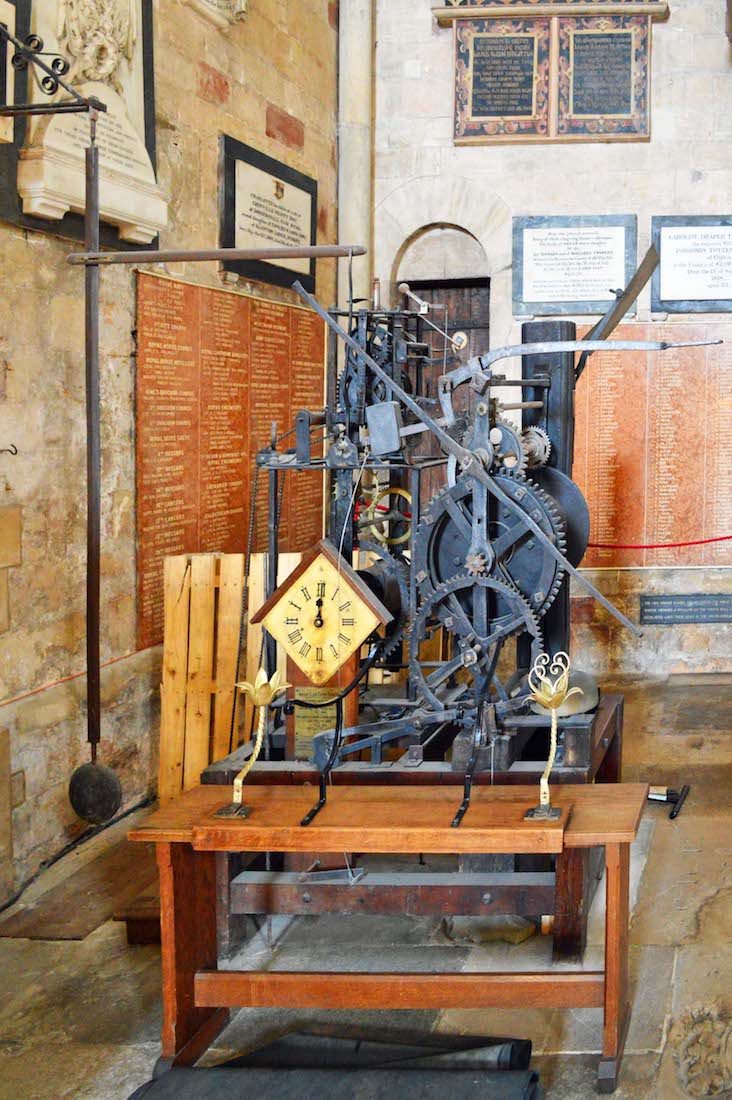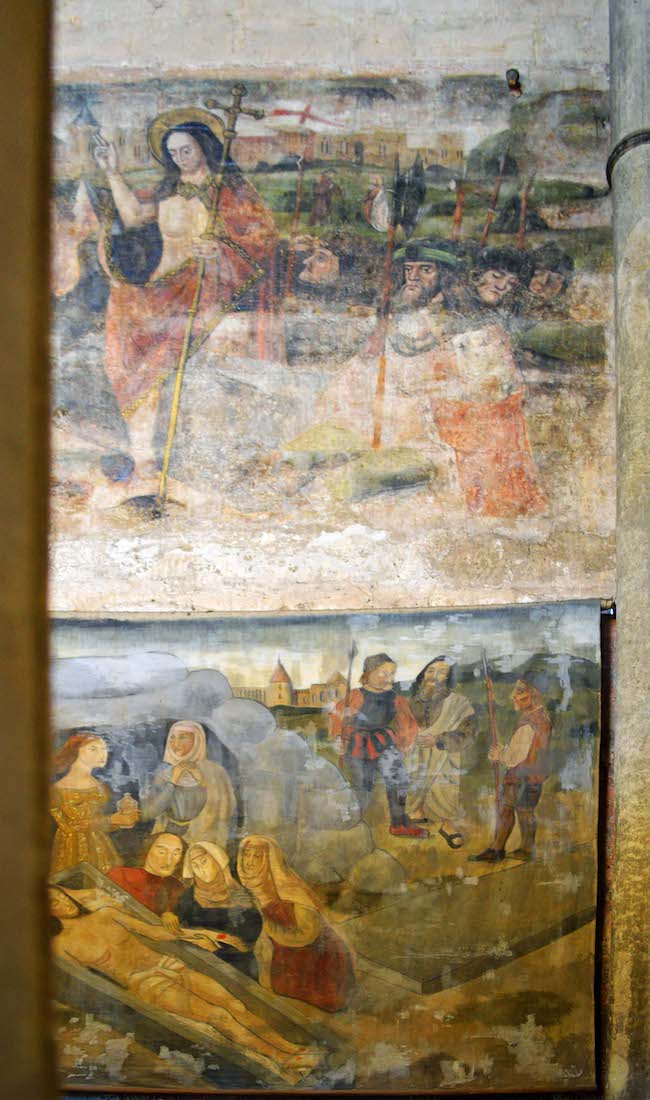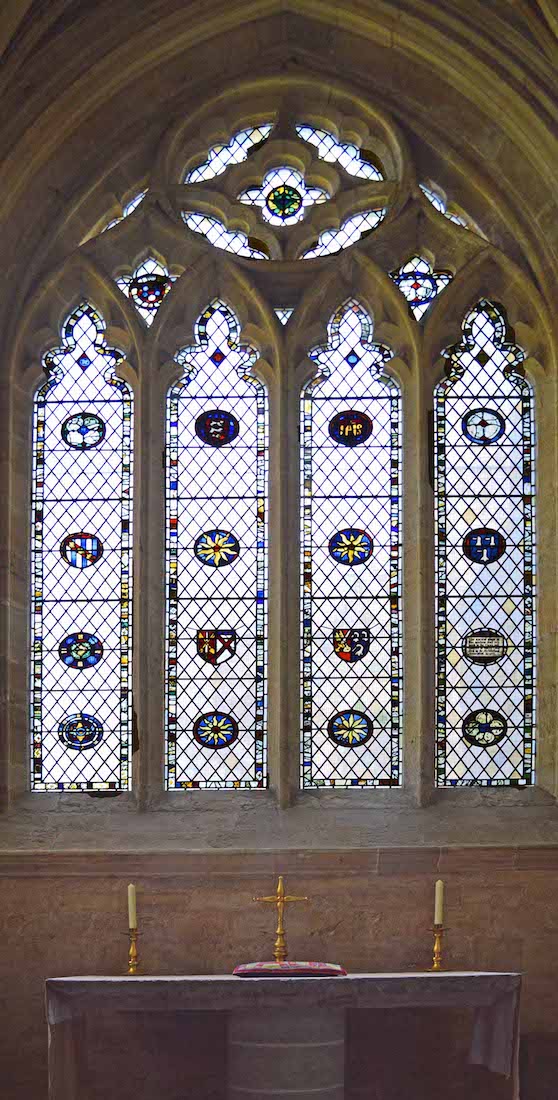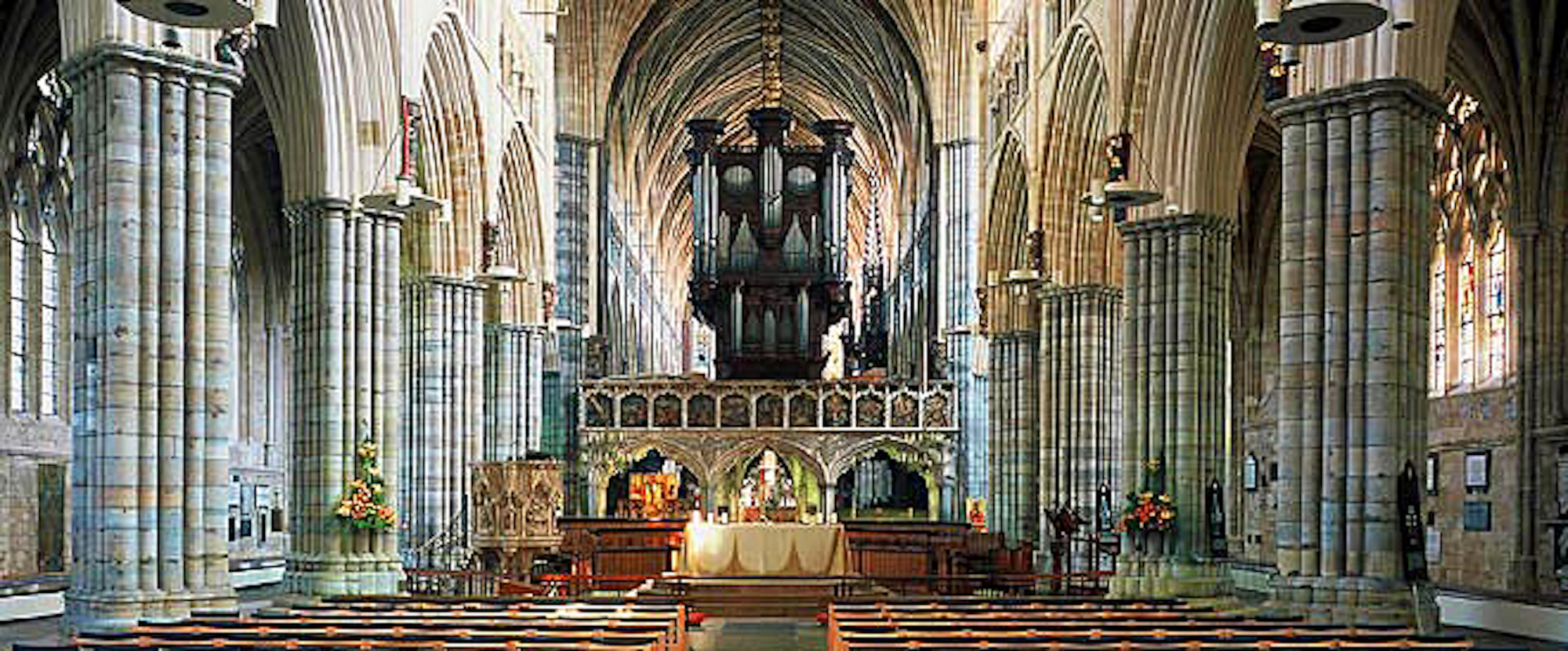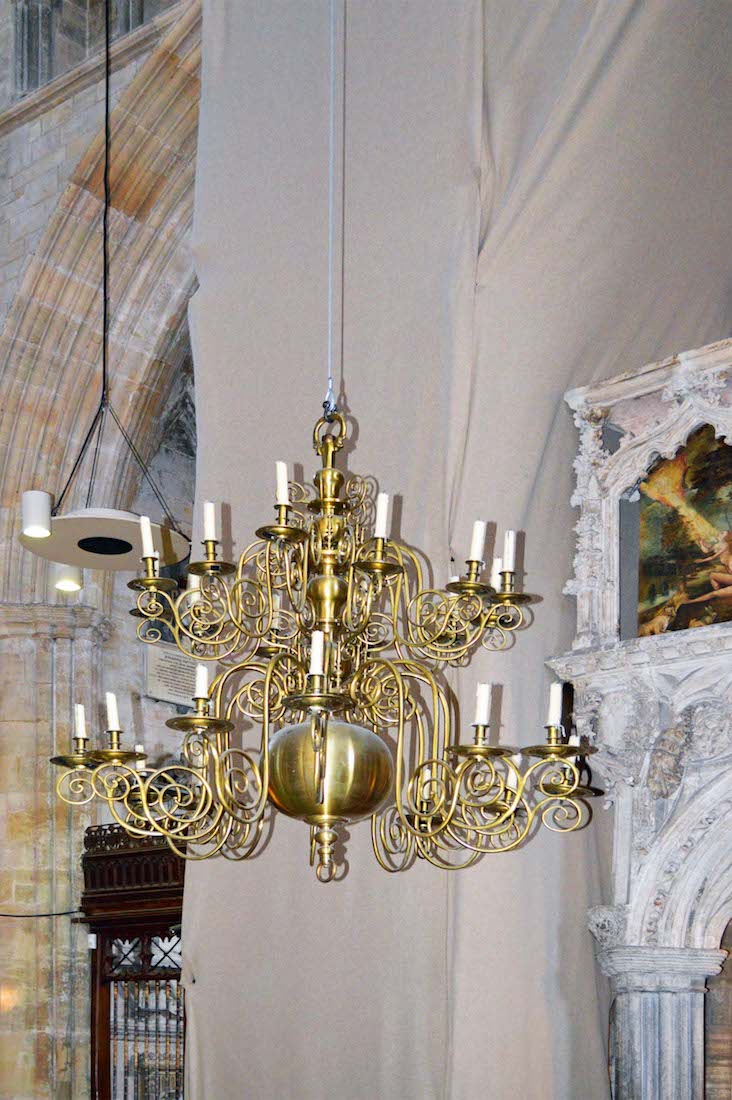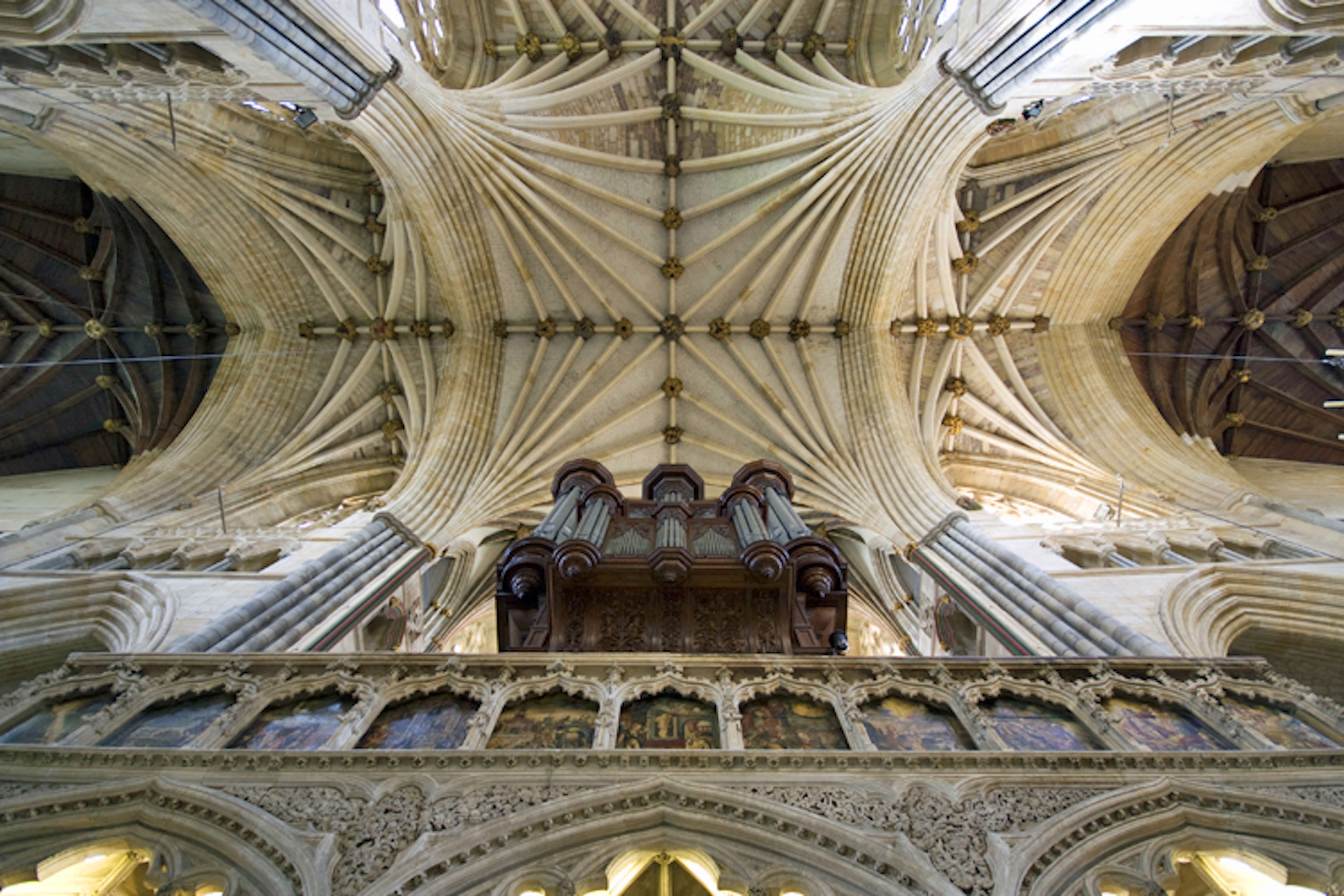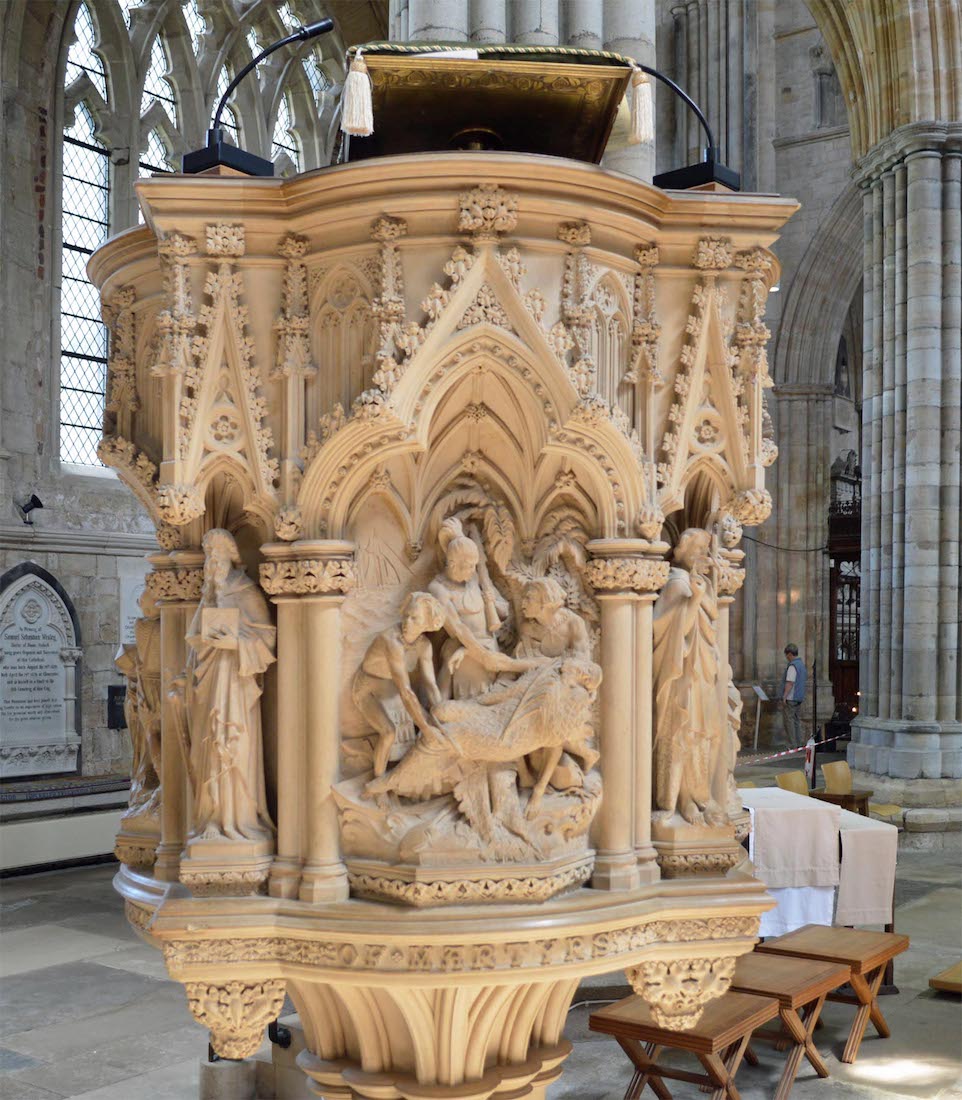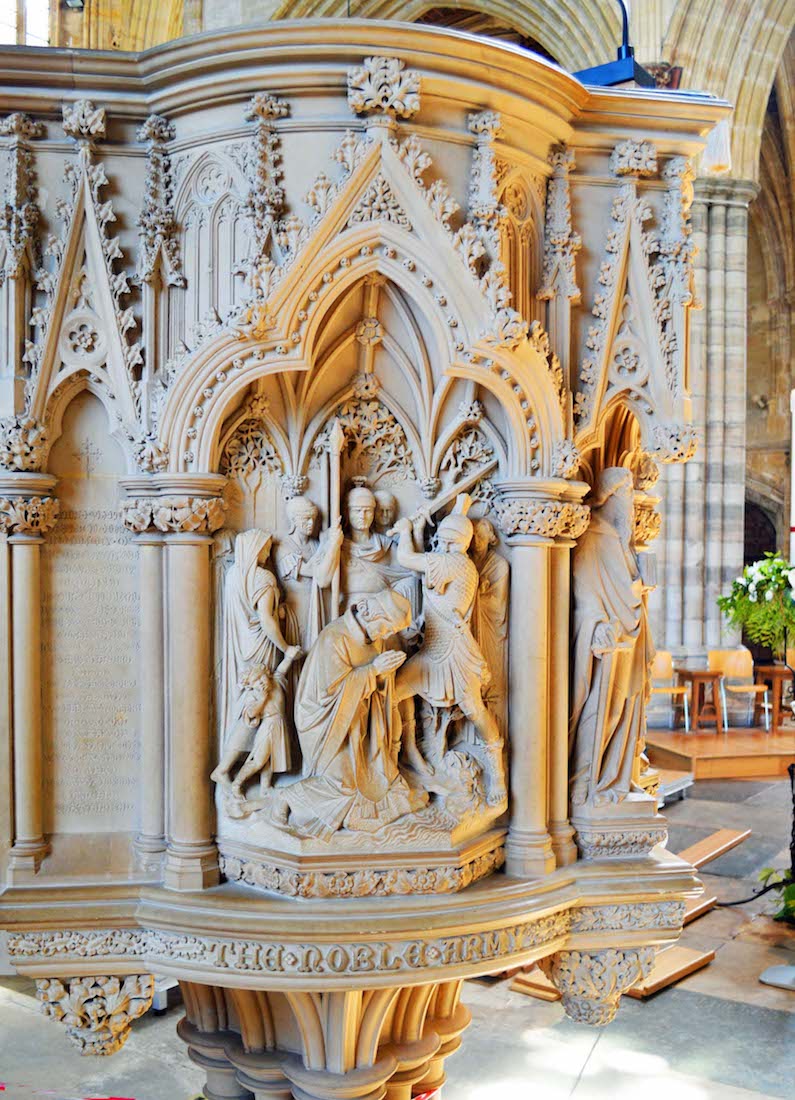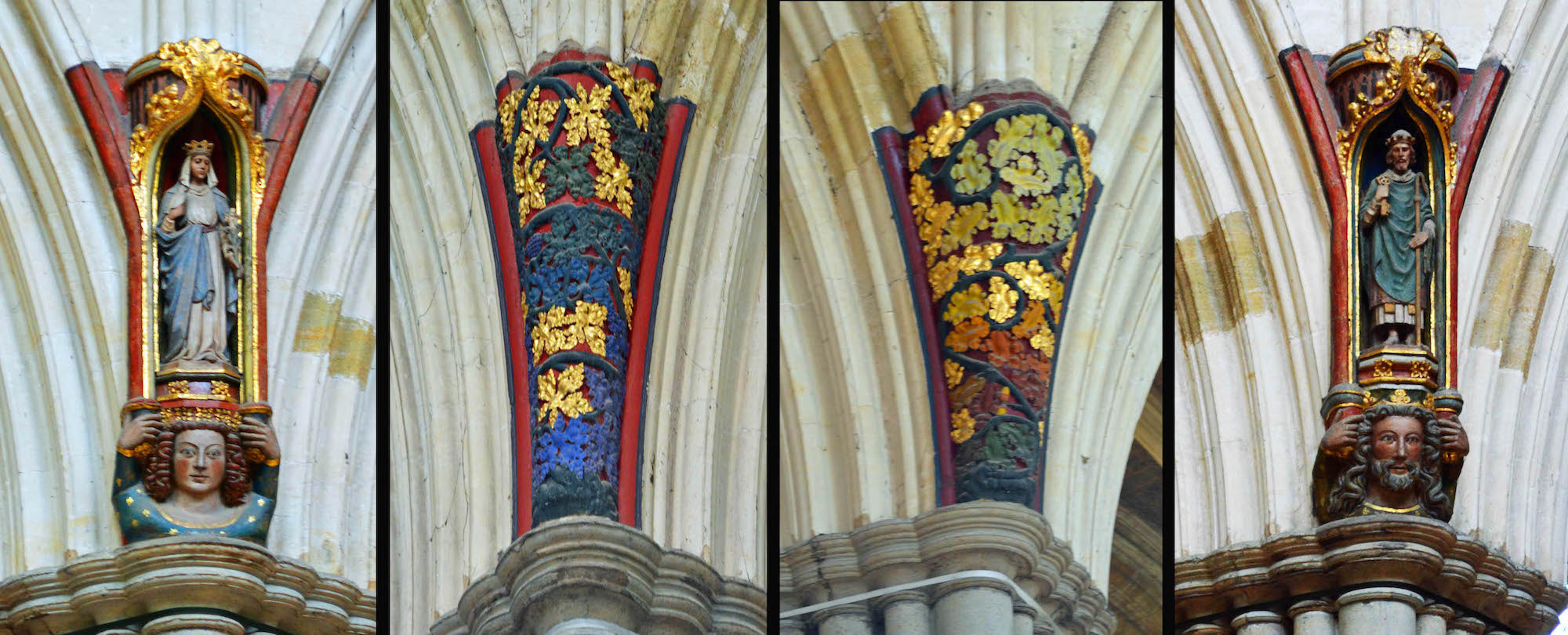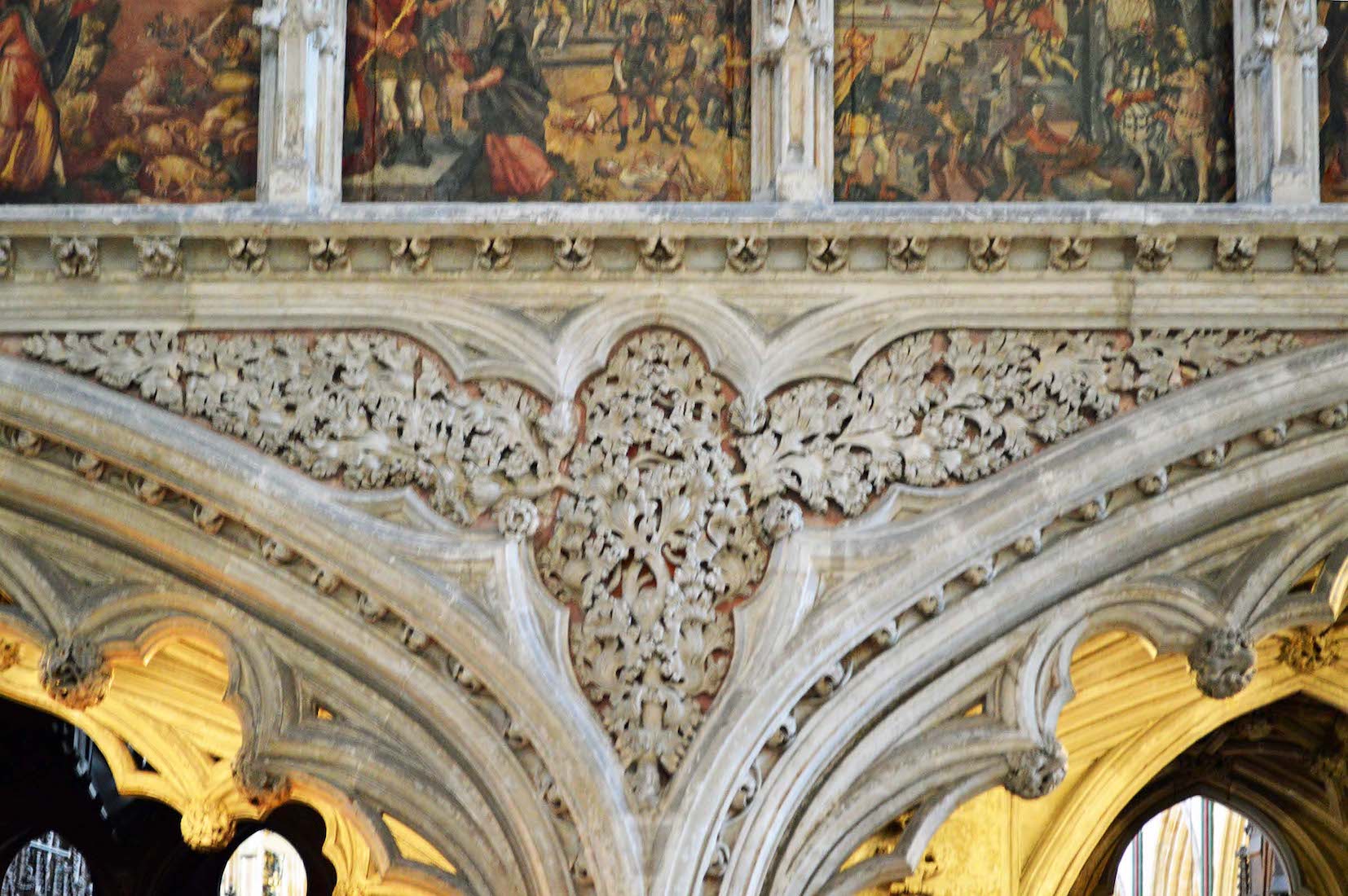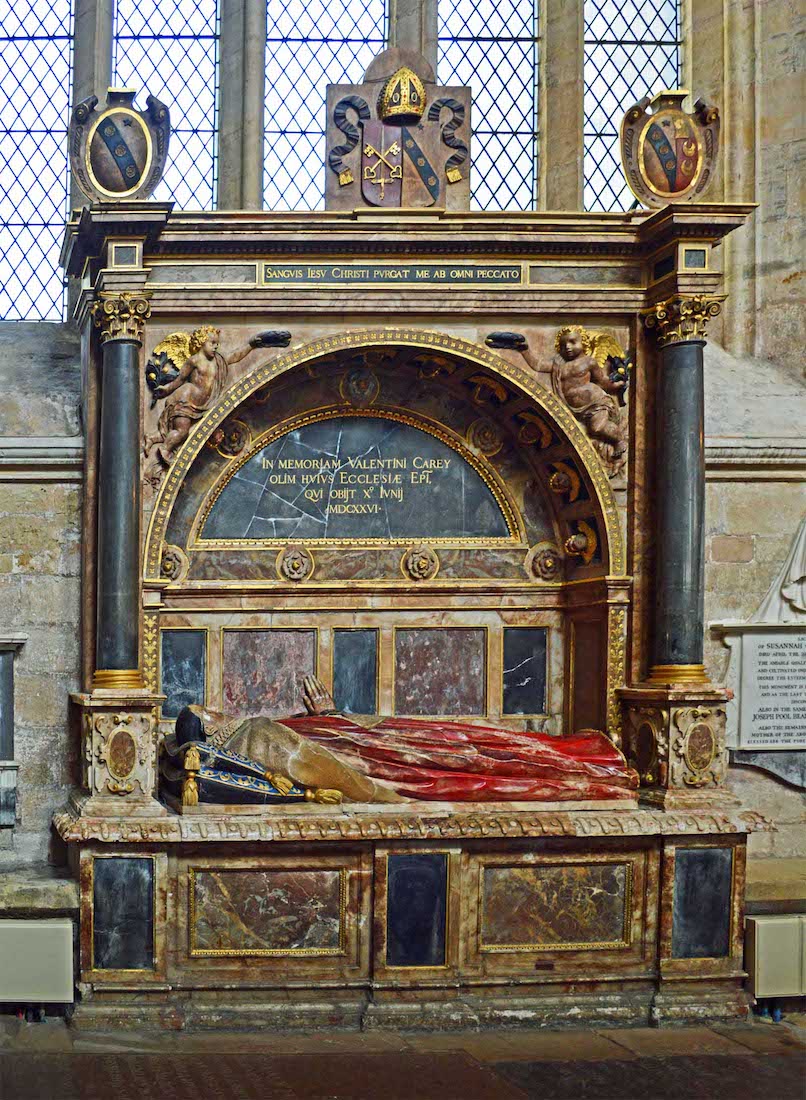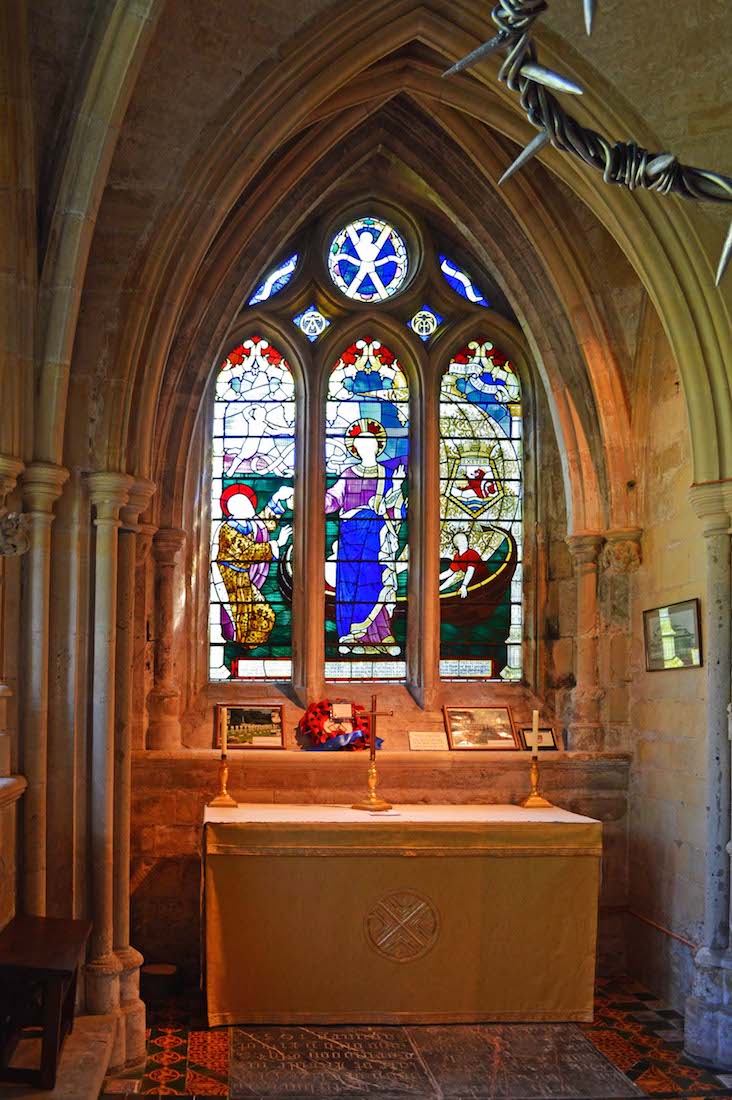41. NORTH AISLE, WEST END
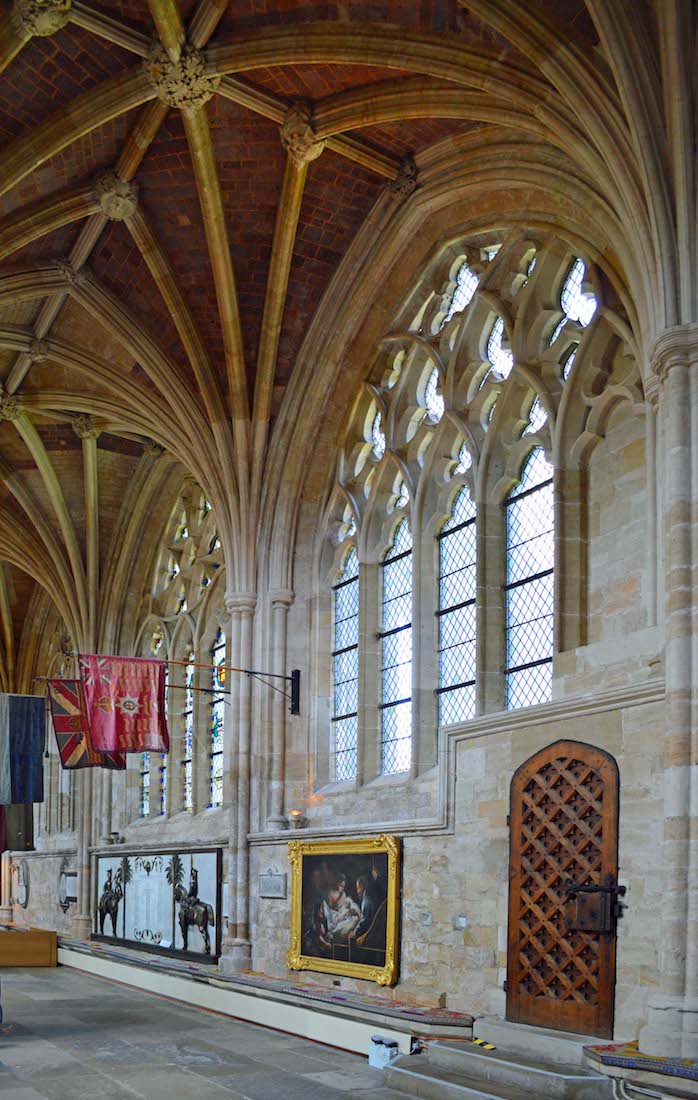
This view looks West along the nave North aisle. The memorial and painting recently viewed are on the left. The wooden door is of interest. It is the door to the Dog Whipper’s apartment. Dog whippers were employed between the 16th and 19th centuries to remove stray dogs from the churches, and to keep dogs under control when they came with their owners to services. They were given a special set of expanding tongs to remove dogs hiding under the pews. Exeter had possibly one of the last recorded dog whippers, John Pickard, who was appointed in 1856. PLAN
42. NORTH AISLE, EAST END
Turning, we look East along the North aisle to view some of the treats in store ... .
43. WESLEY PLAQUE
Of particular interest is this plaque. The name Samuel Sebastian Wesley will be familiar to all who have sung in Anglican choirs. Wesley (1810 – 1876) was an English organist and composer – the greatest English composer of church music of his day. He had a hard life earning enough money, but this was largely his own fault: he was a difficult man with a bad temper and often argued with his employers. He moved to Exeter Cathedral in 1835, where he improved the choir and persuaded the authorities to renovate the organ.
45. ASTRONOMICAL CLOCK FACE
The lower blue dial of this astronomical clock is the oldest part of the clock, dating from 1484. The fleur-de-lys 'hand' indicates the time (and the position of the sun in the sky) on a 24-hour analogue dial. The numbering consists of two sets of I – XII Roman numerals. The silver ball and inner dial show both the age of the moon and its phase (using a rotating black shield to indicate the moon's phase). The upper dial, added in 1760, shows the minutes. The Latin phrase Pereunt et Imputantur, is usually translated as ‘they perish and are reckoned to our account’ referring to the hours that we spend, wisely or not.
46. ASTRONOMICAL CLOCK
The original clockwork mechanism, was much modified, repaired, and neglected until it was replaced in the early 20th century.
47. SYLKE CHANTRY PAINTING
In the North East corner of the North transept is the Sylke Chantry, founded by William Sylke, sub-chanter, buried there in 1508. His effigy is an emaciated figure in a shroud. The Resurrection wall painting in this Chantry was covered in wax in the 1930s, in an attempt to fix flaking paint. In time, the wax coating had caused even more flaking. As the wax also became dark and opaque, the painting was almost obscured. The painting has now been restored revealing great original detail.
48. CHAPEL OF ST PAUL
Next to the Chantry is the little Chapel of St Paul. The window displays a number of unrecognizable logos, although one shield shows the sword and keys of St Peter.
49. CROSSING
Moving now to the centre of the Cathedral we come to the crossing, where nave and transepts meet. This is the focal area of the Cathedral containing the altar from which the Eucharist is served. Frequently in English Gothic cathedrals a crossing tower surmounts this space. It is thought that perhaps Exeter Cathedral decided to retain its two Norman transept towers rather than build a crossing tower, after the collapse of the central tower of Winchester Cathedral in 1107. Exeter is the only English cathedral with two Norman transept towers.
50. CROSSING CHANDELIER
The crossing is lit by two grand chandeliers. These can be raised and lowered by winches within the roof cavity.
51. CROSSING CEILING
This striking photograph is taken looking up past the pulpitum and organ to the crossing roof. The finely clustered columns of Exeter Cathedral are transformed into a fine tracery in the roof pattern. [Cathedral photo]
52. PULPIT
The pulpit was erected in memory of Bishop John Coleridge Patteson who was ordained in Exeter Cathedral. In 1855 Patteson left Britain for New Zealand and the Pacific islands of Melanesia. He devoted the rest of his life to the peoples of Melanesia, but sadly, he was murdered in 1871. The central pulpit panel depicts three islanders placing Bishop Patteson’s body in a canoe to be returned to his ship.
53. PULPIT DETAIL
Another panel depicts the beheading of St Alban, the first British Christian martyr, around 300 AD during the Roman occupation of Britain. The pulpit was designed by Sir George Gilbert Scott in the 1870s.
54. MARY ICON
At the foot of the near (Northern) crossing column is this icon of Madonna and Child. This painting dates from around 1450. A Madonna is a representation of Mary, either alone or with her child Jesus. These images are central icons for both the Catholic and Orthodox churches. The word is from Italian ma donna, meaning ‘my lady’. No image permeates Christian art as the image of the Madonna and child.
55. SOUTH CROSSING ICON
In this Cathedral Church of St Peter, it is entirely appropriate that there should be an icon of St Peter, found here on the South side of the crossing. In old depictions, Christ hands St. Peter a folded or open scroll, on which is often the inscription Lex Domini (Law of the Lord) or Dominus legem dat (The Lord gives the law). Later the scroll was replaced by the Keys of the Kingdom (Matthew 16:19). On this icon, both symbols appear.
56. COLUMN DECORATIONS
Throughout the nave, a variety of colourful decorations appear on the capitals of the Gothic supporting columns. Some of these are flowers and foliage, others are representations of various disciples and saints. St Peter is shown with his defining set of keys. The central two might be called corbels, but they appear to be more decorative than functional.
57. PULPITUM
The pulpitum is a common feature in medieval cathedral and monastic architecture in Europe. It is a massive screen, most often constructed of stone, or occasionally timber, that divides the quire area from the nave and ambulatory. Typically the pulpitum is lavishly carved and decorated. Shown here is the strip of eleven painted scenes adorning the top of the pulpitum at Exeter. This pulpitum was completed in 1325, although the paintings of biblical scenes are 17th-century.
58. SUPPORT DECORATION
The top strip of paintings of the pulpitum is supported by arches with elaborate decoration.
59. VALENTINE CAREY
We leave the crossing and walk up along the North quire aisle. Bishop Valentine Carey DD was Master of Christ’ College Cambridge and Dean of St Paul’s Cathedral, London. He died in London in 1626, and there seems to be some dispute as to whether this is his grave, or whether he was buried at St Paul’s. The insignia above the monument here is interesting: two crossed keys and an inverted sword. The keys have heart-shaped ends, and the symbolism obviously refers to St Peter. It is more common to have an inverted cross in place of the sword, alluding to the belief that Peter was crucified upside down.
60. CHAPEL OF SS ANDREW & CATHERINE
Half way along the North quire aisle is the small Chapel of St Andrew and St Catherine. This appears to be a War Memorial Chapel with the window commemorating the lives of those lost in the Battle of the Java Sea in 1942. HMS Exeter survived the initial conflict, but was badly damaged and sunk a few days later.


